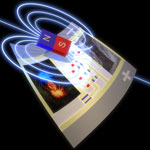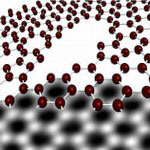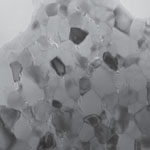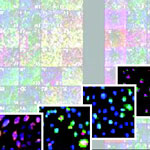Showing Spotlights 1457 - 1464 of 2784 in category All (newest first):
 Printed electronics has emerged as a key research field to meet the requirements of large area and cost-efficient production. The field of modern electronics is very general and includes not only printable interconnects, but also optoelectronics and magnetoelectronics. In this respect, cost-efficient versatile electronic building blocks, such as transistors, diodes and resistors, are already available as printed counterparts of conventional semiconductor elements. However, the element responding to a magnetic field, which is highly demanded for printable electronics, has not yet been realized and printable electronic sensors and contactless switches operating in combination with magnetic fields have not been reported so far. In new work, researchers in Germany have successfully overcome most of these issues. Researchers have now fabricated the first printable magnetic sensor that relies on the giant magnetoresistance (GMR) effect. The developed magneto-sensitive ink can be painted on any substrate - such as paper, polymers, ceramics, and glass - and retains a GMR ratio of up to 8% at ambient conditions. This value is beyond the state of the art.
Printed electronics has emerged as a key research field to meet the requirements of large area and cost-efficient production. The field of modern electronics is very general and includes not only printable interconnects, but also optoelectronics and magnetoelectronics. In this respect, cost-efficient versatile electronic building blocks, such as transistors, diodes and resistors, are already available as printed counterparts of conventional semiconductor elements. However, the element responding to a magnetic field, which is highly demanded for printable electronics, has not yet been realized and printable electronic sensors and contactless switches operating in combination with magnetic fields have not been reported so far. In new work, researchers in Germany have successfully overcome most of these issues. Researchers have now fabricated the first printable magnetic sensor that relies on the giant magnetoresistance (GMR) effect. The developed magneto-sensitive ink can be painted on any substrate - such as paper, polymers, ceramics, and glass - and retains a GMR ratio of up to 8% at ambient conditions. This value is beyond the state of the art.
Jul 19th, 2012
 Although graphene in itself has been dubbed the 'magic' material, if it is to be used for practical applications it has to integrated with the other components of possible devices. For instance, to exploit its amazing electron conduction properties, you still need to connect it to the rest of the circuit with contacts, which are typically made out of metal. Understanding how metals interact - chemically and structurally - with graphene is therefore quite important and researchers have published a number of studies on the subject. In a quite unexpected discovery resulting from these observations, researchers have now found that graphene undergoes a self-repairing process to close holes that are caused by metal atoms. They were able to show that nanoscale holes (perhaps a 100 atoms missing or so), etched under an electron beam at room temperature in single-layer graphene sheets as a result of their interaction with metal impurities, heal spontaneously by filling up with either nonhexagon, graphene-like, or perfect hexagon 2D structures.
Although graphene in itself has been dubbed the 'magic' material, if it is to be used for practical applications it has to integrated with the other components of possible devices. For instance, to exploit its amazing electron conduction properties, you still need to connect it to the rest of the circuit with contacts, which are typically made out of metal. Understanding how metals interact - chemically and structurally - with graphene is therefore quite important and researchers have published a number of studies on the subject. In a quite unexpected discovery resulting from these observations, researchers have now found that graphene undergoes a self-repairing process to close holes that are caused by metal atoms. They were able to show that nanoscale holes (perhaps a 100 atoms missing or so), etched under an electron beam at room temperature in single-layer graphene sheets as a result of their interaction with metal impurities, heal spontaneously by filling up with either nonhexagon, graphene-like, or perfect hexagon 2D structures.
Jul 18th, 2012
 In recent years, there has been growing interest, and progress, in the design and fabrication of carbon nanotube (CNT) macrostructures for effective utilization of their remarkable properties at the macroscale. Realization of such highly concentrated CNT macrostructures in a stiff/elastic environment able to impose compression on individual CNTs and CNT/CNT junctions, could dramatically improve their network connectivity, transport property, and durability, and perhaps lead to novel organic/inorganic hybrids with unprecedented multifunctional properties. In a new study, researchers have effectively addressed this challenge and proposed a new concept - a highly concentrated, 3D macrostructure of individual multiwalled CNTs in a ceramic environment - that dramatically improves not only the transport property and network connectivity of the MWCNT 3D macrostructure but also the strain tolerance of the ceramic material.
In recent years, there has been growing interest, and progress, in the design and fabrication of carbon nanotube (CNT) macrostructures for effective utilization of their remarkable properties at the macroscale. Realization of such highly concentrated CNT macrostructures in a stiff/elastic environment able to impose compression on individual CNTs and CNT/CNT junctions, could dramatically improve their network connectivity, transport property, and durability, and perhaps lead to novel organic/inorganic hybrids with unprecedented multifunctional properties. In a new study, researchers have effectively addressed this challenge and proposed a new concept - a highly concentrated, 3D macrostructure of individual multiwalled CNTs in a ceramic environment - that dramatically improves not only the transport property and network connectivity of the MWCNT 3D macrostructure but also the strain tolerance of the ceramic material.
Jul 17th, 2012
 There is currently no clear evidence that engineered nanoparticles pose a significant threat to the environment. Nonetheless, major gaps in our knowledge exist. The present dossier illustrates the problems in the field of environmental analytics, presents the current state of knowledge on the fate and behavior of ENPs in various environmental compartments and provides an overview of the preliminary results from ecotoxicological research and from model calculations of exposure assessments. At present, ecotoxicological research focuses primarily on controlled laboratory studies involving cell cultures or model organisms. One of the major critiques here is the use of unrealistically high dosages1 Overall, no definitive conclusions can be drawn on whether environmental damage can be expected or not.
There is currently no clear evidence that engineered nanoparticles pose a significant threat to the environment. Nonetheless, major gaps in our knowledge exist. The present dossier illustrates the problems in the field of environmental analytics, presents the current state of knowledge on the fate and behavior of ENPs in various environmental compartments and provides an overview of the preliminary results from ecotoxicological research and from model calculations of exposure assessments. At present, ecotoxicological research focuses primarily on controlled laboratory studies involving cell cultures or model organisms. One of the major critiques here is the use of unrealistically high dosages1 Overall, no definitive conclusions can be drawn on whether environmental damage can be expected or not.
Jul 12th, 2012
 Nanotechnology products, processes and applications have the potential to make important contributions to environmental and climate protection by helping save raw materials, energy and water as well as by reducing greenhouse gases and problematic wastes. Great hopes are being placed on nano-technologically optimized products and processes that are currently under development in the energy production and storage sectors. Emphasis is often placed on the sustainable potential of nanotechnology, but this in fact represents a poorly documented expectation. Determining a product's actual effect on the environment - both positive and negative - requires considering the entire life cycle from the production of the base materials to disposal at the end of its useful life. Not every 'nano-product' is a priori environmentally friendly or sustainable, and the production of nanomaterials often requires large amounts of energy, water and environmentally problematic chemicals.
Nanotechnology products, processes and applications have the potential to make important contributions to environmental and climate protection by helping save raw materials, energy and water as well as by reducing greenhouse gases and problematic wastes. Great hopes are being placed on nano-technologically optimized products and processes that are currently under development in the energy production and storage sectors. Emphasis is often placed on the sustainable potential of nanotechnology, but this in fact represents a poorly documented expectation. Determining a product's actual effect on the environment - both positive and negative - requires considering the entire life cycle from the production of the base materials to disposal at the end of its useful life. Not every 'nano-product' is a priori environmentally friendly or sustainable, and the production of nanomaterials often requires large amounts of energy, water and environmentally problematic chemicals.
Jul 11th, 2012
 Understanding the health and environmental impact of nanomaterials is vital to the sustainable and responsible development of nanotechnology. Currently, small animal experiments are the 'gold standard' for nanomaterial toxicity testing. However, a detailed understanding often requires dozens of animals and can take many months to complete. Dr. Andre Nel and his coworkers at the California NanoSystems Institute (CNSI) and the University of California Los Angeles (UCLA) are taking a fundamentally different approach to nanomaterial toxicity testing. Nel believes that, under the right circumstances, resource-intensive animal experiments can be replaced or adjusted with comparatively simple in vitro assays. This article explores his approach and its implications for nanomaterial design and development.
Understanding the health and environmental impact of nanomaterials is vital to the sustainable and responsible development of nanotechnology. Currently, small animal experiments are the 'gold standard' for nanomaterial toxicity testing. However, a detailed understanding often requires dozens of animals and can take many months to complete. Dr. Andre Nel and his coworkers at the California NanoSystems Institute (CNSI) and the University of California Los Angeles (UCLA) are taking a fundamentally different approach to nanomaterial toxicity testing. Nel believes that, under the right circumstances, resource-intensive animal experiments can be replaced or adjusted with comparatively simple in vitro assays. This article explores his approach and its implications for nanomaterial design and development.
Jul 9th, 2012
 A commentary by Steffen Foss Hansen and Anders Baun in this week's Nature Nanotechnology pointedly asks "when will governments and regulatory agencies stop asking for more reports and reviews, and start taking regulatory action?" The two scientists take issue with yet another scientific opinion on nanosilver that has been requested by the European Commission in late 2011: "SCENIHR - Request for a scientific opinion on Nanosilver: safety, health and environmental effects and role in antimicrobial resistance". Specifically, the EC wants SCENIHR to answer four questions under the general heading of 'Nanosilver: safety, health and environmental effects, and role in antimicrobial resistance'. These questions, however, have already been addressed by no less than 18 review articles in scientific journals.
A commentary by Steffen Foss Hansen and Anders Baun in this week's Nature Nanotechnology pointedly asks "when will governments and regulatory agencies stop asking for more reports and reviews, and start taking regulatory action?" The two scientists take issue with yet another scientific opinion on nanosilver that has been requested by the European Commission in late 2011: "SCENIHR - Request for a scientific opinion on Nanosilver: safety, health and environmental effects and role in antimicrobial resistance". Specifically, the EC wants SCENIHR to answer four questions under the general heading of 'Nanosilver: safety, health and environmental effects, and role in antimicrobial resistance'. These questions, however, have already been addressed by no less than 18 review articles in scientific journals.
Jul 4th, 2012
 Over the past few years, touchscreens have become ubiquitous in the world of mobile electronic devices. A next generation of touch sensing devices will be vastly more advanced and lead to ultrasensitive artificial skins. Another, novel model for advanced man-machine interactive systems could be based on moisture detectors. Here, actual touch is no longer necessary for a positioning interface to react; rather, the distribution of water molecules that exists around all humid surfaces, such as a human finger, would be sufficient to trigger a response. Researchers in China have now demonstrate such a flexible touchless positioning interface based on the spatial mapping of moisture distribution.
Over the past few years, touchscreens have become ubiquitous in the world of mobile electronic devices. A next generation of touch sensing devices will be vastly more advanced and lead to ultrasensitive artificial skins. Another, novel model for advanced man-machine interactive systems could be based on moisture detectors. Here, actual touch is no longer necessary for a positioning interface to react; rather, the distribution of water molecules that exists around all humid surfaces, such as a human finger, would be sufficient to trigger a response. Researchers in China have now demonstrate such a flexible touchless positioning interface based on the spatial mapping of moisture distribution.
Jul 3rd, 2012
 Printed electronics has emerged as a key research field to meet the requirements of large area and cost-efficient production. The field of modern electronics is very general and includes not only printable interconnects, but also optoelectronics and magnetoelectronics. In this respect, cost-efficient versatile electronic building blocks, such as transistors, diodes and resistors, are already available as printed counterparts of conventional semiconductor elements. However, the element responding to a magnetic field, which is highly demanded for printable electronics, has not yet been realized and printable electronic sensors and contactless switches operating in combination with magnetic fields have not been reported so far. In new work, researchers in Germany have successfully overcome most of these issues. Researchers have now fabricated the first printable magnetic sensor that relies on the giant magnetoresistance (GMR) effect. The developed magneto-sensitive ink can be painted on any substrate - such as paper, polymers, ceramics, and glass - and retains a GMR ratio of up to 8% at ambient conditions. This value is beyond the state of the art.
Printed electronics has emerged as a key research field to meet the requirements of large area and cost-efficient production. The field of modern electronics is very general and includes not only printable interconnects, but also optoelectronics and magnetoelectronics. In this respect, cost-efficient versatile electronic building blocks, such as transistors, diodes and resistors, are already available as printed counterparts of conventional semiconductor elements. However, the element responding to a magnetic field, which is highly demanded for printable electronics, has not yet been realized and printable electronic sensors and contactless switches operating in combination with magnetic fields have not been reported so far. In new work, researchers in Germany have successfully overcome most of these issues. Researchers have now fabricated the first printable magnetic sensor that relies on the giant magnetoresistance (GMR) effect. The developed magneto-sensitive ink can be painted on any substrate - such as paper, polymers, ceramics, and glass - and retains a GMR ratio of up to 8% at ambient conditions. This value is beyond the state of the art.
 Subscribe to our Nanotechnology Spotlight feed
Subscribe to our Nanotechnology Spotlight feed





